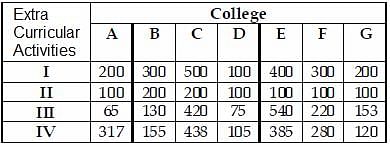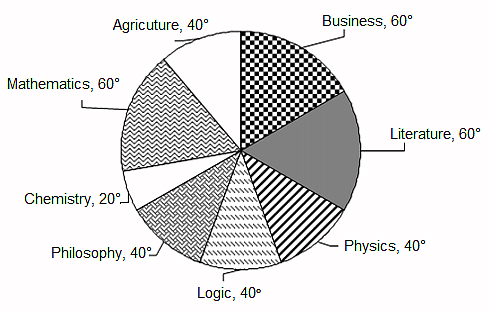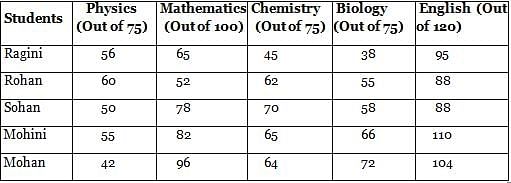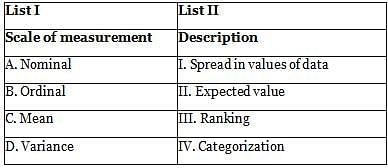APSET Paper 1 Mock Test - 3 - AP TET MCQ
30 Questions MCQ Test APSET Mock Test Series 2025 - APSET Paper 1 Mock Test - 3
Which of the following can be a physiological barrier to communicator?
| 1 Crore+ students have signed up on EduRev. Have you? Download the App |
Directions: Study the given table and answer the following question.
The following table shows the number of students of 7 colleges participating in extra curricular activities:

Q. Percentage of the number of students in activity II to that of IV is
The following table shows the number of students of 7 colleges participating in extra curricular activities:

Select the option that is related to the third word in the same way as the second word is related to the first word.
Biology : Science : : Political Science : ?
Direction: Read the given passage and answer the questions that follow.
Early feminist theory had emphasised the commonalities of women's oppression, neglecting profound differences between women in terms of class, age, religion, race and nation. As its exclusionary nature became evident, the collective 'we' of feminism was called into question. The inadequacies of feminist theorising that conflated the condition of white, middle class women with the condition of all women were highlighted in North America by black and Latin feminists, and in Britain by black and Asian feminists. Such critiques evoked the concepts of 'inter‐locking identities' and inter‐locking oppressions'. Related and more radical analyses came from feminist scholars in the Third world, where quite different agendas were called for. These critiques heightened the irrelevance of western feminism's analytical frameworks to the lives of most women around the world and attempted to reposition feminist debate within broader social, economic and cultural contexts of analysis advocated by scholars such as Janus. Such critiques spoke from a post‐colonial position, in which the self‐assumed authority of western feminists to speak about or indeed for others was disputed and decentered. Influential accounts of the tendencies of masculinist imperialist ideological formation to construct a 'monolithic Third world' woman', discursively constituted as the universal victim of Third world patriarchy, challenged feminists to "unlearn" their privilege and to deconstruct their own authority as intellectuals. These positions appeared to question the legitimacy of outside intervention of any kind, whether intellectual or political. Although subsequently attempted by the Third world scholars anxious to move beyond standpoints that threatened to mark all feminist politics as either inauthentic or unnecessary, they were enduringly influential in highlighting the questions identity and authority in feminist studies.
Q. The analytical frameworks of western feminists were critiqued by Third world scholars as:
Directions: Read the following passage carefully and answer the question.
I had occasion to work with her closely during the Women's International Year in 1975 when she was chairing a Steering Committee and made me the member in charge of publicity. Representatives from different political parties and women's organisations were on the committee, and though the leftists claimed a sort of proprietary right over her, Aruna encouraged and treated all members alike. It was not her political affiliations or her involvement in a particular cause, which won her respect and recognition, but her utter honesty in public life, her integrity and her compassion for the oppressed which made her an adorable person. She had the courage to differ with and defy the mightiest in the land; yet her human spirit prompted her to work in the worst of slums to offer succour to the poor and the exploited.
In later years – around late eighties and early nineties – Aruna Asaf Ali's health began to deteriorate. Though her mind remained alert, she could not actively take up her pet causes – action for women's advancement, planning for economic justice, role of media, reaffirmation of values in public affairs etc. Slowly, her movements were restricted and Aruna, who had drawn sustenance from common people, from her involvement in public life, became a lonely person. She passed away in July 1996.
Q. Who were made the members of the Committee of Publicity?
(i) Representatives from different political parties
(ii) Representatives from the leftist parties
(iii) Representatives from the women's organisations
(iv) None of the above
Directions: Answer the given question based on the following data.
Total number of students in the university = 2160

Q. On a particular day, if the students of Mathematics, Physics and Chemistry go on a strike and all the students of other disciplines attend the classes, find the ratio of the total number of Agriculture students to the total number of students who attend the classes.
Which of the following areas of liberal education at the higher level in the feudal society of Europe were classified under quadrivium?
A. Grammar
B. Logic
C. Arithmetic
D. Astronomy
E. Music
Choose the correct answer from the given options.
Direction: Read the information carefully and answer the following question.
For a country, CO2 emission (million metric tons) from various sectors are given in the following table.

Q. What is the percentage % growth of CO2 emissions from the power sector from 2005 to 2009?
Directions: Answer the given question based on the following table.
Marks obtained by 6 candidates A, B, C, D, E and F:

Q. The marks obtained by C in English were what percentage more than those obtained by F in Maths?
Match List - I with List - II and select the correct answer using the codes given below:

The difference between the ages of two men is 10 years. 15 years ago, the elder one was twice as old as the younger one. The present age of the elder man is
Which one of the following references is written according to American Psychological Association (APA) format?
Directions: Read the following passage carefully and answer the given question.
The catalytic fact of the twentieth century is uncontrollable development, consumerist society, political materialism, and spiritual devaluation. This inordinate development has led to the transcendental ‘second reality’ of sacred perception that biologically transcendence is a part of human life. As the century closes, it dawns with imperative vigour that the ‘first reality’ of enlightened rationalism and the ‘second reality’ of the beyond have to be harmonised in a worthy state of man. The defacto values describe what we are, they portray the ‘is’ of our ethic, they are est values (Latin est means is). The ideal values tell us what we ought to be, they are esto values (Latin esto ‘ought to be’). Both have to be in the ebb and flow of consciousness. The ever new science and technology and the ever-perennial faith are two modes of one certainty, that is the wholeness of man, his courage to be, his share in Being.
The materialistic foundations of science have crumbled down. Science itself has proved that matter is energy, processes are as valid as facts, and affirmed the non-materiality of the universe. The encounter of the ‘two cultures’, the scientific and the humane, will restore the normal vision, and will be the bedrock of a ‘science of understanding’ in the new century. It will give new meaning to the ancient perception that quantity (measure) and quality (value) coexist at the root of nature. Human endeavours cannot afford to be humanistically irresponsible.
Q. Encounter of the 'two cultures', the scientific and the human implies
Directions: Read the below information carefully and answer the question that follow.
The bar graph shows revenue (in lakhs) of a food company that sells different kinds of food items:

Q. What is the growth in total revenue from 2004 to 2006?
Given below are two statements:
Statement I: 300-meter long train crosses a platform of the same length in 30 seconds. Speed of train 10m/sec.
Statement II: The average speed is the mean of speed.
In light of the above statements, choose the correct option given below.
Direction: Read the following excerpt and answer the questions asked at the end. The answers to the questions should be based on the excerpt.
Although water covers approximately sixty seven percent of the Earth's surface, of this less than three percent is fresh water. Accounting for fresh water locked in glaciers, ice-caps or otherwise inaccessible, less than a tenth of a percent of the Earth's water is available for human consumption. Pollution, population growth and wasteful irrigation practices are contributing to a worldwide water shortage. When the clear precious liquid becomes scarce, countries begin to assert claims on fresh water supplies. As a result, drinkable water has become a region of conflict that could eventually lead to greater hostilities between nations.
Some countries such as the United States, have ample sources of water. In other nations, such as China, water is less plentiful. As water resources dwindle, competition for available sources will rise. Nations may claim rights to a particular body Of fresh water or they may plan to build dams and other projects on rivers. If two or more nations which disagree on water rights or building projects, conflicts can emerge. In order to combat this issue many countries are adopting water conservation and security solutions. The United Nations has implemented programs to combat potential issues that could lead to violence.
Q. What percent of the surface of the earth covered with water, is available for human consumption?
In respect of computer software, features of a typical operating system include:
A. The interface‐allowing communication between the user and the computer
B. Memory management‐allocating internal memory (RAM) to programs and data in use and retrieving and storing data on the external memory devices
C. Resource handling‐controlling peripheral devices (input and output devices) and handling user requests for peripheral devices
D. Internet access‐providing connectivity to the services on the Internet
Choose the correct answer from the options given below:
Which of the following is also known as a web address?
Direction: Read the following passage carefully and answer the question.
If India has to develop her internal strengths, the nation has to focus on the technological imperatives, keeping in mind three dynamic dimensions: the people, the overall economy and the strategic interests. These technological imperatives also take into account a ‘fourth’ dimension, time, an offshoot of modern-day dynamism in business, trade, and technology that leads to continually shifting targets. We believe that technological strengths are especially crucial in dealing with this fourth dimension underlying continuous change in the aspirations of the people, the economy in the global context, and the strategic interests. The progress of technology lies at the heart of human history. Technological strengths are the key to creating more productive employment in an increasingly competitive market place and to continually upgrade human skills. Without a pervasive use of technologies, we cannot achieve the overall development of our people in the years to come. The direct linkages of technology to the nation’s strategic strengths are becoming more and more clear, especially since the 1990s. India’s own strength in a number of core areas still puts it in a position of reasonable strength in the geopolitical context. Any nation aspiring to become a developed one needs to have strengths in various strategic technologies and also the ability to continually upgrade them through its own creative strengths. For people-oriented actions as well, whether for the creation of large scale productive employment or for ensuring nutritional and health security for people or for better living conditions, technology is the only vital input. The absence of greater technological impetus could lead to lower productivity and wastage of precious natural resources. Activities with low productivity or low-value addition, in the final analysis, hurt the poorest most. The technological imperatives to lift our people to a new life, and to life, they are entitled to be important. India, aspiring to become a major economic power in terms of trade and increase in GDP, cannot succeed on the strength of turnkey projects designed and built abroad or only through large-scale imports of plant machinery, equipment and know-how. Even while being alive to the short-term realities, medium and long-term strategies to develop core technological strengths within our industry are vital for envisioning a developed India.
Q. According to the above passage, which of the following are indicative of the fourth dimension?
1) Aspirations of people
2) Modern day dynamism
3) Economy in the global context
4) Strategic interests
Code:
The following tables shows marks obtained out of 100 by Sunita and Jessica in five subjects:

Based on the table above identify the correct statement from the following:
Direction: Study the following table chart carefully and answer the question given beside.
The following table represents the Maximum marks of five subjects and marks obtained by five students in five subjects.

Q. Marks obtained by Ragini in Chemistry and Biology together is what percent of the marks obtained by Mohini in Physics and Mathematics together?
Match List I with List II

Choose the correct answer from the options given below.
Direction: Study the following line graphs and answer the given questions.
The graph shows the ratio of marks of History to Geography of 7 students in an examination.

Q. How many students got more marks in History than in Geography?
|
60 tests
|


 720
720 240
240





















